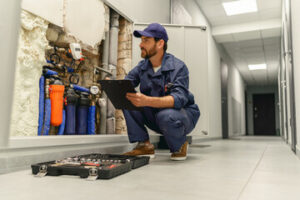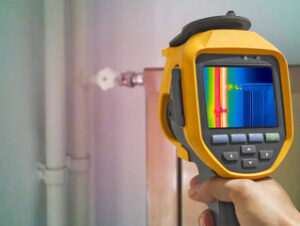Plumber Provo installs, repairs, and maintains pipes and fixtures for water distribution and waste management in homes and businesses. They must have strong customer service skills to listen to clients and troubleshoot problems effectively.

A high school diploma is the minimum education required to become a plumber. Many take an apprenticeship to learn the trade and gain experience, then work their way up through the ranks of journeyman and master plumber.
A faucet handle is a hollow cylinder slightly longer than a hand-width, with a stiff wire passing through it at right angles to both ends of the cylinder. The wire is shaped into a hook at each end, to permit comfortable carrying of the cylinder with otherwise bare hands by distributing the force over a larger area. This allows you to use a lot more power than you could if you grasped it directly.
Plumbers must have excellent customer service skills because they often work directly with clients. They also need to be able to explain complex plumbing issues in easy-to-understand terms.
The part of a faucet on which the handle rests. The seat of the faucet should be undamaged and not worn. Also known as the nut. (aviation, military, slang) A seat on an ejection device. He was ready to get the hell out of his seat! (figuratively) A position or membership in an organization. She is a member of the board. She has a good seat in the company.
These examples are automatically compiled from various online sources.
Cylinder
A cylinder is a three-dimensional figure that has two circular bases that are congruent to each other and does not have any vertices. The surface of a cylinder is curved and the total area that is occupied by its curved surface is equal to 2prh, where r is the radius of the base and h is the height of the cylinder. Toilet paper rolls, cold drink cans, and the Leaning Tower of Pisa are real-life examples of cylinders. A cylinder is also used in industrial equipment such as hydraulic cylinders, which are responsible for powering machinery.
Whenever a hydraulic cylinder is damaged, it can impact the efficiency of the entire system. This can result in higher energy costs and reduced performance. In addition, this type of damage can put additional stress on other components, leading to broken pins and accelerated wear in bearings. This can lead to expensive repairs, or even system failures.
Before deciding whether to repair or replace the cylinder, it is important to understand what caused its failure. If you do not find out why the cylinder failed, you could end up replacing it with a new one that experiences the same issue. Getting to the root of the problem can save you time and money in the long run.
When it comes to repairing hydraulic cylinders, you should always weigh the cost of the repair against the cost of a replacement. The key to making this decision is understanding the cause of the problem and what kind of damage has been done to the cylinder. If a particular part of the cylinder is damaged, a simple repair can solve the problem at a lower cost than a complete replacement.
A plumber needs to have a variety of skills to be successful in their job. These include a deep understanding of different systems and the ability to use a wide range of tools. In addition, a plumber must be familiar with safety procedures and follow industry standards. This will ensure that the job is done correctly and safely for all parties involved.
Seals
The seals on your faucet are vital to its function, but over time, they can become worn out due to repeated contact with water. This can result in leaks or low water pressure. Replacing the seals is a simple DIY job, and it can restore your faucet’s efficiency. You can also keep the seals clean by regularly wiping them down with a damp cloth. However, you should be careful not to rub the seals too hard, as this can damage them.
Plumbers install plumbing systems for both residential and commercial clients. Their responsibilities include laying pipes, installing toilets and faucets, and connecting appliances like dishwashers and washing machines. They also repair and maintain existing plumbing systems. This can involve using specialized equipment like video cameras to inspect pipes and pressure gauges to test for leaks. Plumbers also need to be able to read blueprints and architectural plans in order to properly install plumbing systems in new construction projects.
A career as a plumber can be very rewarding, but it requires a certain level of skill and knowledge. Most plumbers learn their trade through an apprenticeship, which combines classroom instruction with on-the-job training. However, there are also many vocational schools and community colleges that offer courses in plumbing. These programs typically last four to five years and can lead to a certification or associate degree.
In addition to their technical skills, plumbers must be able to effectively communicate with customers. This includes explaining complex issues in simple terms and providing clear estimates for work. They must also be able to work safely, as they often work with dangerous tools and in tight spaces.
If you’re interested in a career as a plumber, start by getting your high school diploma or equivalent. Then, find a local apprenticeship program that offers classroom instruction and paid on-the-job training. Once you’ve completed your apprenticeship, pass a background check and obtain a license to work in your state. You can then start your own plumbing business or join a large plumbing company. You can also pursue a degree in engineering or plumbing technology to increase your opportunities in the field.








